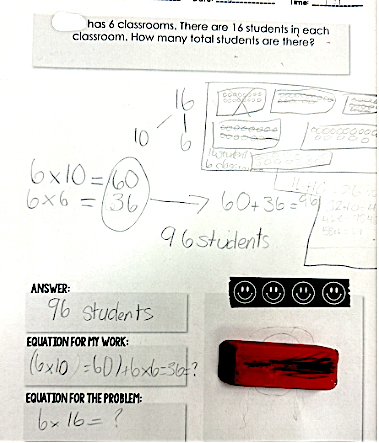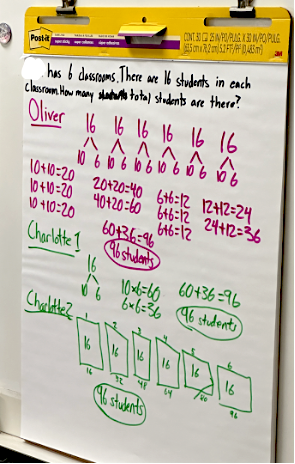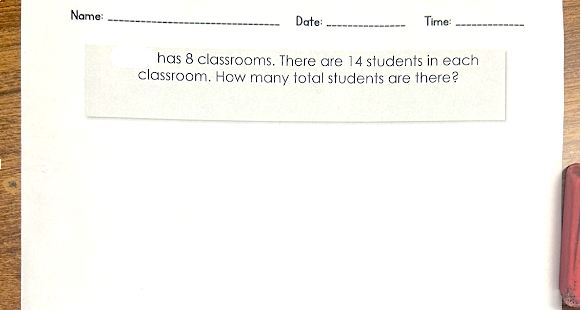By Mona Iehl
 In my early years of teaching, I poured hours into perfecting every detail of my lessons. I explained concepts step by step, answered every question, and followed my plans down to the letter. Yet, despite my best efforts, my students still struggled – they just weren’t connecting. Their understanding and progress fell short even though I thought I was doing everything right.
In my early years of teaching, I poured hours into perfecting every detail of my lessons. I explained concepts step by step, answered every question, and followed my plans down to the letter. Yet, despite my best efforts, my students still struggled – they just weren’t connecting. Their understanding and progress fell short even though I thought I was doing everything right.
That’s what ultimately led me to find a different strategy – one that placed students at the center. Through what I decided to call the “Word Problem Workshop,” I shifted my approach to give students ownership of their learning.
Instead of explaining every detail, I began guiding them through a process: launching a problem, grappling with it, discussing strategies, and finally reflecting on their learning. Suddenly, my students were engaged and thinking critically. Watching them tackle problems, build confidence, and support one another showed me that true learning happens when students are empowered to take charge of their problem solving process.
Today, I want to zoom in on what I believe is the most important – yet often overlooked or sacrificed for the sake of time – step in this process: Reflection.
Reflection helps students identify and solidify what they’ve learned. As John Dewey famously said, “We do not learn from experiences, but by reflecting on those experiences.” While I’m a big advocate of ‘learning by doing’ and making sure my students get hands-on opportunities to dive into their learning, I’ve found that the “doing” alone isn’t enough.
Years ago, I taught my students about bees’ crucial role in the ecosystem and how urban beekeeping can make a positive impact. We spent days at a local conservatory observing bees, helping with a new hive, and learning from experts. But back in the classroom, students struggled to connect what they had experienced with our discussions. I realized I hadn’t facilitated any reflection to help them cement their learning.
So the next time we visited the bees, I made a change. After observing, drawing, and taking notes as usual, we returned to school and reviewed our observations in pairs. I then led a brief share-out where students named their takeaways and new discoveries. Finally, I asked them to record these insights in their journals. This simple debrief allowed students to connect their experience with their learning and understand the importance of reflection in solidifying new knowledge.
Word Problem Workshop
Reflection is an important part of Word Problem Workshop, a student-centered approach to problem solving math word problems. Through this four-step daily math routine, students take on the ‘heavy lifting’ – thinking, solving, grappling, and revising their approaches with challenging problems. Each twenty-minute workshop creates a supportive environment where students can confidently take risks and see themselves as problem solvers.
Built on strong community norms and high expectations, Word Problem Workshop encourages every student to engage fully in making sense of problems and sharing their mathematical ideas. Here, students embrace productive struggle, collaborate, and develop the habits of mathematicians, building deep mathematical understanding over time.
There are four seemingly simple but powerful steps in Word Problem Workshop that engage every learner in problem-solving.
Step 1: Launch – Prepares students to make sense of the problem and take the first step toward a solution.
Step 2: Grapple – Gives students time to dive into the problem, take risks, and learn through trial and error as they work through their solution pathway.
Step 3: Discuss – A student-led discussion where 2-3 selected students share their strategies, allowing everyone to consider different approaches.
Step 4: Reflect – Offers time to review the experience of solving and discussing, helping students solidify and apply their new learning to future problems.
The most important part of Word Problem Workshop is the opportunity at the end of the workshop to reflect. Step four gives students time to process and consolidate what they’ve learned during the grapple and discussion. This reflection time allows students to make notes, solve a similar problem and apply new skills, or even set a goal and track their progress. It’s a crucial time for students to solidify their new learning and prepare to apply it in future challenges. Teachers also use this time to assess students’ understanding, both formally and informally, by observing how they apply new skills.
Promoting Reflection during Word Problem Workshop
Giving students one more problem after the grapple and discussion allows them to solidify and test their newfound strategies. This new problem allows students to solidify what they’ve just learned and apply their thinking to a fresh challenge. Without this brief reflection and application time, we risk losing the momentum and insights generated during the workshop.
Spending just 3 minutes on this final step can make a significant difference. After the discussion and grapple, students are brimming with new ideas, connections, and strategies to try. This is the perfect time for them to test what they’ve learned in a low-pressure environment. If we skip this step, we might lose the valuable progress made during the workshop.
This “quick check” helps students not only apply what they’ve learned but also boosts their confidence in solving future problems. It’s a crucial step that ensures students are ready to move forward with a deeper understanding and a stronger set of skills. Let’s look at an example from the intermediate grades. If you teach in middle school, think about how this reflection strategy might look at your grade level.
If the problem students solved was:
“Our school has 6 classrooms. There are 16 students in each classroom. How many total students are there?”
The image below shows how one student solved during Grapple Time (Step 2). The second image shows the strategies shared and discussed with the whole class on the chart paper during the discussion (Step 3).
The second image shows the strategies shared and discussed with the whole class on the chart paper during the discussion (Step 3).
Notice that the strategies shared showed decomposing as well as repeated addition, skip counting, and multiplication. At the end of each discussion students make a conjecture about something they believe is true about math. Sometimes we call these “math truths.” Students use their mathematical thinking, models, and discussions to prove these truths are true and justify their reasoning.
This discussion ended with students building on their understanding of multiplication and strategies for solving multiplication problems. Their conjecture was “Multiplication is also repeated addition and can be made simpler by decomposing larger numbers.” The teacher offered another problem (below) to offer an opportunity for students to try a different strategy or apply their new learning to this problem.
You’ll notice that this problem is the same context with different numbers of the same complexity. This allows students to focus on the application of their learning instead of making sense of the problem. Here we are checking for their understanding of math, not their ability to make sense of problems and persevere in solving.
After the discussion in Word Problem Workshop the teacher, Mr. D, asked students to head back to their desks from their seat in the circle to solve the next problem. He prompted them, “Go back and solve the next problem. Remember this is an opportunity to show what you may have learned here today. We will turn this in for feedback so be sure to make your thinking clear, accurate and precise. All right, go ahead.” Students hopped up eagerly off to solve another complex word problem!
The “next” problem typically:
● Is the same problem type
● Has the same level of complexity (in numbers and context)
● Has a limited amount of time to complete (similar to grapple time)
● Is framed as an opportunity to show what you’ve learned
● Is graded and used to give students feedback
Another Way to Reflect
Reflection isn’t limited to solving one more problem. Students can and should reflect on their mathematical behaviors, which are key to developing a growth mindset. Jo Boaler’s 2015 book, Mathematical Mindsets, emphasizes the importance of cultivating a growth mindset in math. She highlights the trauma many students experience with math and stresses that effort and persistence are more valuable than the answer itself.
This mindset is central to Word Problem Workshop, where students build problem-solving skills and confidence through perseverance and a positive approach to challenges.
Try This: Give your students a prompt, such as:
- “I persevered in solving today.”
- “I tried a new strategy.”
- “I listened to my classmates to understand their perspective.”
Then, ask for a response from all students. You could do this by:
- Writing 1, 2, or 3 in the corner of their paper (1 = not at all, 2 = somewhat, 3 = yes!).
- Giving a signal like thumbs up, middle, or down.
- Using the 1, 2, 3 scale.
This quick and easy reflection helps students recognize there is more to problem solving than getting the answer and putting their math thinking on paper. It also shifts their focus toward the many ways they are growing as a problem solver.
Reflection in Action
This article is draft content for an upcoming book designed to help teachers like you empower your students to become problem solvers. I understand the challenge of helping students tackle word problems and engage in solving them, which is why the book will offer a practical routine you can use in your classroom with your existing resources.
As someone who practices what I preach, I am currently reflecting on and revising this book for its upcoming release! I’d love to hear your thoughts on this piece of the work. After reading, please email me at mona@monamath.com and share your reflections on these questions:
- What did you find most useful in this article?
- Are there areas you’d like to explore further?
I look forward to hearing from you and continuing the conversation.
Mona Iehl (@HelloMonaMath) is a teacher and coach in Chicago, Illinois. She begain her 17-year career in the primary grades but found her passion in the middle grades. This year Mona has taken on the role of supporting math learning as an instructional coach. For more details about the teaching methods and support Mona offers, visit her website and browse her other MiddleWeb posts.
As a former math avoider, Mona is passionate about helping every teacher and student find their inner mathematician through episodes of her podcast. Listen at @HonestMathChat. If you’re looking for resources for math tasks, word problems, math community and fluency visit Mona’s TPT shop.




